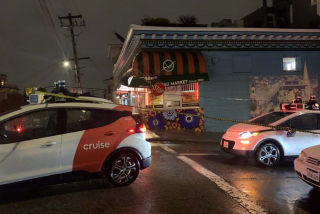Tico Taxis Not Tough Enough for Lima’s Pandemonium
- Share via
LIMA, Peru — Being out in Lima’s chaotic traffic is often like being caught in a stampede of elephants and Peru’s most common taxi -- the Daewoo Tico -- is the scurrying mouse underfoot.
And this tiny, four-door Korean import often gets squashed. Lima’s tabloids frequently carry gory photos of catastrophic Tico accidents, with bodies ensnared in the twisted wreckage.
Now, after a decade as Peru’s unregulated king of cabs, the Tico faces new government safety rules that threaten to put it out of the taxi business.
Among requirements, the new Transportation Ministry rules include a mandate that cars weigh at least 2,200 pounds to be used as taxis. Ticos weigh less than 1,980 pounds.
“The Tico is not designed for use as a taxi,” said Lino de la Barrera, a traffic safety expert and an architect of the regulations. “The possibility of a fatal accident is greater in a Tico.”
There are no government statistics that single out Tico accidents, but Tico owners say their rates for state-mandated personal injury insurance are 20% higher than for owners of other car models.
Derided as rolling death traps by upper- and middle-class Peruvians, Ticos are cheaper than other taxis and are the cab of choice in Lima’s poorer neighborhoods.
They also represent a vital source of income for tens of thousands of struggling Peruvians who pay the equivalent of about $9 to rent the cars for 12-hour shifts, then drive like maniacs to recoup their expenses and turn a modest profit.
“The changes are unfair, but I don’t think they are going to be enforced,” Carlos Tiburcio said from behind the steering wheel of the yellow Tico he bought seven years ago. “The problem isn’t that Ticos are fragile; the problem is that people here don’t know how to drive.”
Daewoo stopped producing the Tico in 2000, but secondhand “Super Ticos,” so named for their electric windows and molded side panels, are still shipped to Peru.
Ticos are used almost exclusively as taxis here, although most are not registered for that purpose, says Manuel Neyra, administrative chief of Lima’s transportation authority.
Neyra says he does not agree that the Tico’s design is inherently dangerous. He blames most Tico-related accidents on the inexperience of typically young cab drivers.
“Any kid can grab his father’s car and go to work as a taxi driver with no professional training or knowledge of the rules,” Neyra said.
Ticos made their debut in Peru in 1994 after auto import tariffs were relaxed and public transportation was deregulated to ease a transportation shortage. Daewoo offered easy credit, putting the economy car within reach of low-income Peruvians.
According to government figures, at least 58,000 Ticos were imported to Peru in the last decade, but experts say the figure is not precise. Sergio Baigorria, a Tico importer, estimates that the actual number is more than 80,000.
Baigorria gained cult-hero status with Tico drivers after he souped up one of his cars and rode it to a third-place finish in the 2002 Road of the Incas race -- a grueling 1,820-mile traverse through the Andes.
He says he wanted to show that the Tico’s poor reputation stems from how “the car is driven, not the car itself.”
“What the government is doing is insane,” he said. “It’s only going to create more unemployment.”
Tico owners have until this month to get their taxis inspected, but Barrera says the cars are almost sure to fail tougher inspection standards.
“The majority of them are rented out and are really beaten up,” he said.
There is a darker side to the Tico phenomenon.
Perhaps because they have zippy engines and can disappear into a sea of the unregulated mini-hatchbacks, Ticos are a favorite getaway car in strong-arm robberies and holdups.
Cabby Jesus Moreno, 36, says he found that out when he picked up two average-looking guys. The one in the front passenger seat pulled a pistol, while the one in back grabbed him around the neck and held a knife to his throat. They took the Tico and disappeared.
“The next day, I found out they used my taxi to rob two gas stations,” he said.
More to Read
Sign up for Essential California
The most important California stories and recommendations in your inbox every morning.
You may occasionally receive promotional content from the Los Angeles Times.










